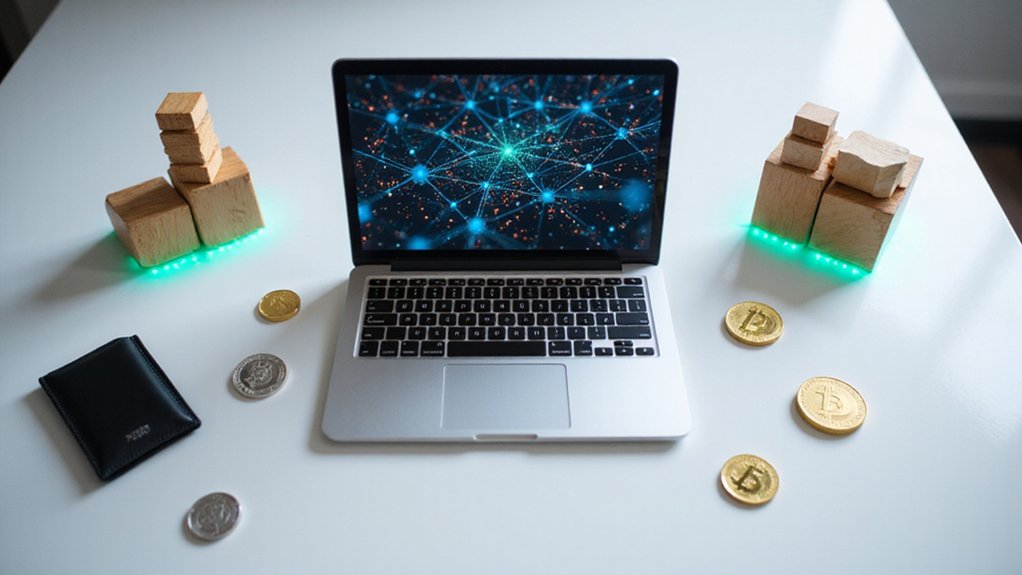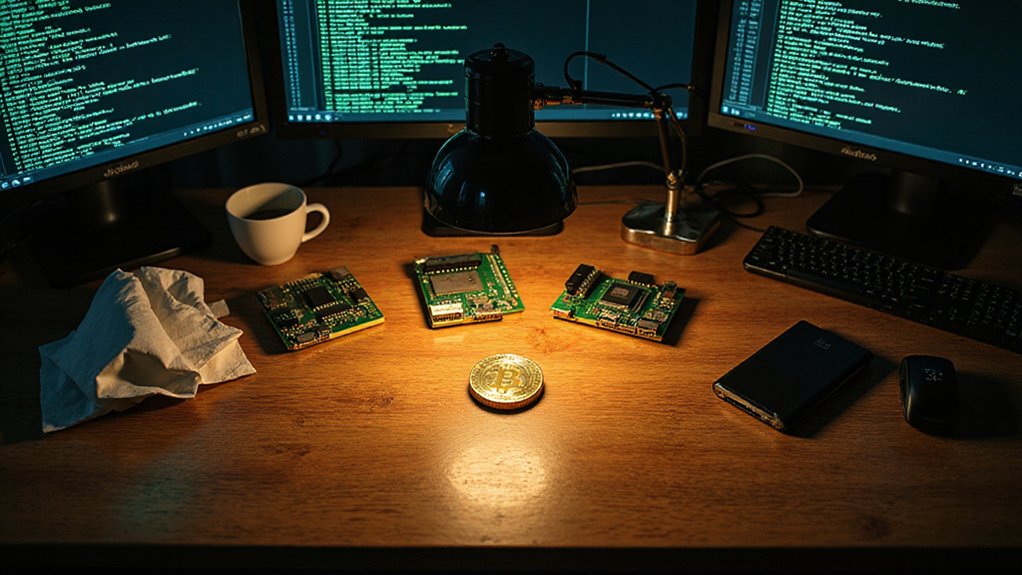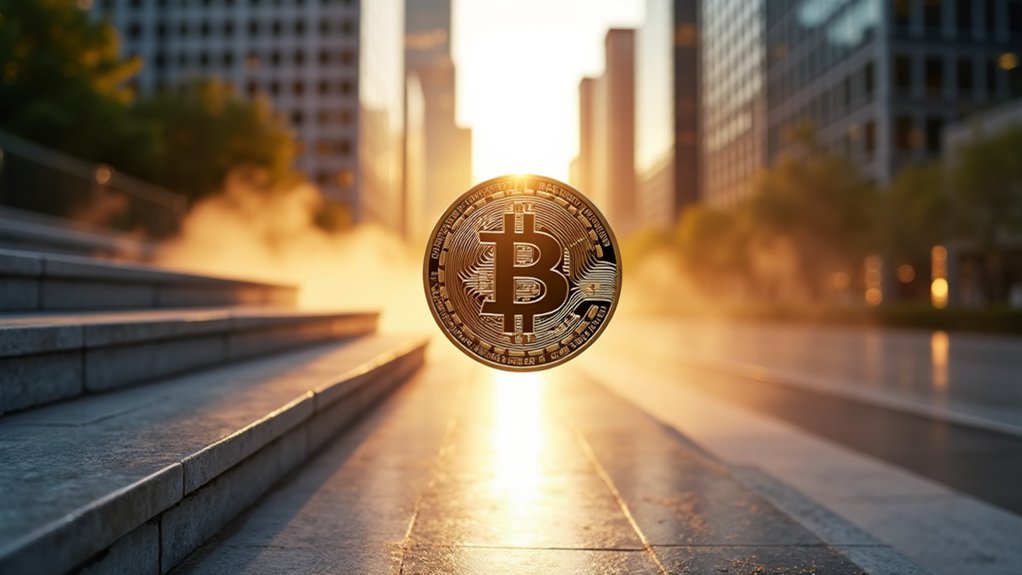AAVE ($17.9 billion TVL) dominates DeFi lending with flash loans and cross-chain compatibility, while Lido Finance ($14.6 billion TVL) revolutionizes staking by maintaining liquidity on locked Ethereum. Uniswap ($3.2-4 billion TVL) pioneered automated market making, though impermanent loss remains an occupational hazard for liquidity providers. Curve Finance ($2.1 billion TVL) optimizes stablecoin swaps with minimal slippage. Hardware wallets like Ledger Stax secure substantial holdings as this trillion-dollar ecosystem—projected to reach $1.5 trillion by 2034—transforms traditional finance into programmable protocols worth exploring further.

The decentralized finance landscape has evolved from experimental protocols into a trillion-dollar ecosystem where traditional banking functions operate without banks—a development that would have seemed fantastical just a decade ago, yet now attracts institutional capital with the gravitational pull of a financial black hole.
AAVE emerges as the undisputed lending champion with approximately $17.9 billion in total value locked (TVL), offering everything from standard loans to flash loans—financial instruments that let users borrow astronomical sums for microseconds, because apparently regular borrowing wasn’t complex enough.
AAVE lets users borrow billions for microseconds through flash loans, because traditional lending clearly lacked sufficient complexity.
The platform’s cross-chain compatibility demonstrates how DeFi protocols have matured beyond Ethereum’s occasionally prohibitive gas fees, though smart contract vulnerabilities remain an occupational hazard that keeps security auditors employed.
Lido Finance commands $14.6 billion TVL through liquid staking, solving Ethereum’s staking dilemma by allowing users to earn rewards while maintaining liquidity—a innovation that transforms previously locked capital into tradeable assets.
This represents financial engineering at its most elegant, turning regulatory necessity into profitable opportunity. Many DeFi users appreciate staking rewards as they provide passive income similar to traditional savings accounts while supporting network consensus mechanisms.
Uniswap revolutionized token swaps through automated market making, maintaining $3.2-4 billion TVL despite the perpetual threat of impermanent loss that haunts liquidity providers like a particularly persistent financial specter.
The platform’s user-friendly interface masks sophisticated algorithms that would make traditional market makers weep into their Bloomberg terminals.
Curve Finance specializes in stablecoin trading with $2.1 billion TVL, optimizing for low-slippage swaps between assets that theoretically maintain equal value—though recent stablecoin adventures have demonstrated that “stable” remains a relative concept in cryptocurrency markets.
JustLend rounds out the lending category with $3.7 billion TVL, while Summer.fi adds another $2.1 billion to the competitive landscape.
Integration requires careful wallet selection, with hardware wallets like Ledger Stax recommended for substantial holdings, because storing significant assets in software wallets demonstrates either remarkable courage or questionable judgment. Hardware wallets provide offline storage while maintaining access to DeFi protocols through secure connection methods.
These platforms undergo regular security audits, though the rapid pace of innovation means yesterday’s bulletproof code occasionally becomes tomorrow’s expensive lesson in humility.
Market dependency remains the sector’s Achilles’ heel, with TVL fluctuating alongside broader cryptocurrency sentiment. The DeFi market’s trajectory appears particularly aggressive, with projections indicating growth from $32.36 billion in 2025 to an astronomical $1,558.15 billion by 2034, reflecting a CAGR of 53.8% that would make traditional finance executives question their career choices.
Frequently Asked Questions
What Are the Tax Implications of Using Defi Platforms?
DeFi platforms generate numerous taxable events that users often overlook—token swaps, staking rewards, liquidity mining, and airdrops all trigger tax obligations.
The IRS treats these activities as ordinary income or capital gains, requiring meticulous record-keeping of transaction dates, fair market values, and wallet addresses.
Despite decentralization’s perceived anonymity, blockchain transparency guarantees government tracking capabilities remain intact, making compliance essential regardless of platform sophistication.
How Do I Recover Funds if I Lose My Private Keys?
Recovering lost private keys requires pre-existing backup measures—recovery phrases (typically 12-24 words), encrypted key files, or platform-specific recovery tools.
Without these safeguards, funds become permanently inaccessible, transforming one’s digital assets into expensive digital art.
Recovery procedures vary dramatically across platforms: Blockchain.com utilizes standard seed phrases, while others like Fordefi demand external devices and specialized files.
All recovery attempts should occur offline to prevent interception during this vulnerable process.
What Happens to My Assets if a Defi Platform Gets Hacked?
When DeFi platforms suffer breaches, users typically face substantial losses with minimal recovery prospects.
Unlike traditional banking’s deposit insurance, decentralized protocols offer no safety nets—assets simply vanish into attackers’ wallets.
Some protocols attempt bounty negotiations or community-driven recovery efforts, though success rates remain dismally low.
The decentralized nature that attracts users ironically eliminates recourse mechanisms, creating a rather paradoxical situation where financial freedom includes freedom from financial protection.
Can I Use Defi Platforms if I Live in a Restricted Country?
Users in restricted countries can technically access DeFi platforms through VPNs and offshore services, though doing so carries significant legal risks.
While China maintains blanket crypto bans, India and Russia permit trading with payment restrictions, and Egypt relies heavily on P2P workarounds.
The decentralized nature of blockchain makes enforcement challenging, yet users must weigh potential regulatory violations against access benefits—a rather precarious cost-benefit analysis.
What’s the Minimum Amount Needed to Start Using Defi Platforms?
Unlike traditional finance’s gatekeeping mechanisms, DeFi platforms typically require no minimum investment beyond transaction fees—often mere dollars in gas costs.
However, practical considerations emerge: Ethereum’s notorious gas fees can eclipse small transactions, making sub-$100 amounts economically questionable.
Layer-2 solutions and alternative blockchains offer lower barriers, though one might question whether someone lacks sufficient capital to absorb network fees possesses adequate risk tolerance for DeFi’s inherent volatility.









